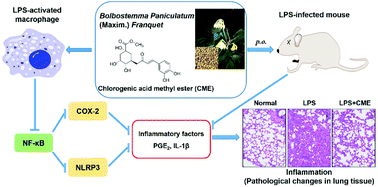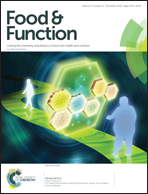Chlorogenic acid methyl ester exerts strong anti-inflammatory effects via inhibiting the COX-2/NLRP3/NF-κB pathway
Abstract
The objective of this study was to investigate the anti-inflammatory effect of chlorogenic acid methyl ester (CME) and the molecular mechanism involved, through using non-infectious inflammation and infectious inflammation animal models as well as lipopolysaccharide (LPS)-stimulated mouse macrophage RAW264.7 cell models. Our results demonstrated that CME markedly inhibited ear swelling, paw swelling and granuloma swelling, and decreased intraperitoneal capillary permeability in non-infectious inflammation. Moreover, CME significantly alleviated the pathological damage of the lung tissue, reduced the levels of PGE2 and IL-1β in the serum and the protein expression levels of related-inflammatory factors in the lung tissue of LPS-induced mice with acute lung injury (ALI). In addition, CME affected the RAW264.7 cell cycle and inhibited the protein expressions of COX-2 and NLRP3 and prevented the phosphorylation of NF-κB p65 in RAW264.7 cells treated with LPS. These observations not only validated the anti-inflammatory effects of CME, but also revealed the underlying molecular basis, which involves the down-regulation of the expression of inflammatory factors and blockade of the COX-2/NLRP3/NF-κB signaling pathway.



 Please wait while we load your content...
Please wait while we load your content...